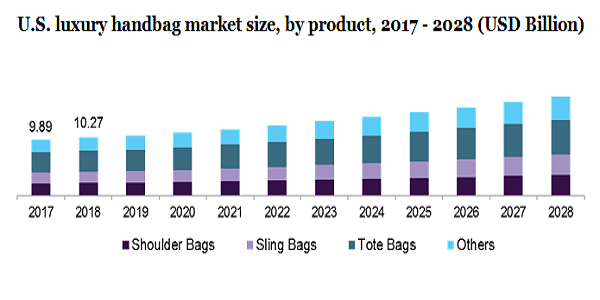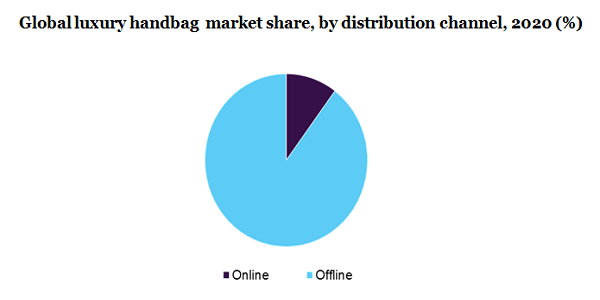- US: +1-408-610-2300
- Toll Free: +1-866-831-4085
- Become a Client
The global luxury handbag market size was valued at USD 62.30 billion in 2020 and is expected to expand at a compound annual growth rate (CAGR) of 5.3% from 2021 to 2028. The market is driven by the introduction of multipurpose or convertible handbags from various players in the market and increasing product innovation. The increasing working women population worldwide is the major factor boosting market growth over the forecast period. According to Pew Research Center Analysis Report 2016, in more than 80 countries, women make up to 40% of the workforce. Furthermore, the workforce's median female share is 45.5% in countries, including the U.S., Canada, France, and the U.K.
 Increasing internet penetration globally, along with easy access to social media websites, such as Instagram and Facebook, will also drive the market for luxury handbags. In the fashion world, a handbag is considered to be the most important accessory to evaluate a look of a model. Increasing preference for luxury branded goods and the growth in disposable income in the developing economies are the primary factors driving the market. Moreover, brand power and recognition of luxury logos are expected to drive the market over the forecast period.
Increasing internet penetration globally, along with easy access to social media websites, such as Instagram and Facebook, will also drive the market for luxury handbags. In the fashion world, a handbag is considered to be the most important accessory to evaluate a look of a model. Increasing preference for luxury branded goods and the growth in disposable income in the developing economies are the primary factors driving the market. Moreover, brand power and recognition of luxury logos are expected to drive the market over the forecast period.
The rising use of social media and the internet helps customers understand products before making a purchase. With the increasing working women population, the manufacturers of luxury handbags are developing handbags fortified with mobile holders, laptop sleeves, and key holders that provide a luxury feel without compromising the quality. The demand for men's luxury handbags is increasing as they have identified luxury handbags as a lifestyle product.
Tote luxury handbag accounted for the largest share of the luxury handbag market with almost 36.0% in 2020. It allows the consumer to carry several goods at the same time due to its larger space. Hence, it is popular among working women as they require enormous space to keep important stuff, such as files and laptops. Moreover, these bags are available for every consumer requirement, which is eventually increasing their demand. Additionally, shifting consumers' preferences from plastic bags to tote bags is estimated to fuel the segment growth in the coming years.
Sling luxury handbag is expected to witness the highest growth over the forecast period owing to its increasing demand. As the number of fashion-freak customers is increasing, the demand for sling bags is also rising. In addition, manufacturers are adopting different market strategies to increase their customer base. Online advertisement of sling bags, celebrity endorsements, and increasing preference among buyers are likely to drive the segment over the forecast period.
The leather segment accounted for the largest share of the luxury handbag market with over 47.0% in 2020. The segment is estimated to witness significant growth over the forecast period owing to the increasing number of brands, improving luxury lifestyle, and transformed business approach. The growing demand has compelled the manufacturers to increase the prices of the finished goods. This may result in less supply of leather handbags to high-end consumers.
The synthetic segment is expected to register the highest growth rate over the forecast period as synthetic luxury handbags do not get damaged or stained easily and are also washable. These are mostly considered to be luxury vegan handbags. Synthetic bags are one of the functional and top-notch accessories for girls. Increasing demand for synthetic luxury handbags is estimated to boost segment growth during the forecast period.
The offline distribution channel accounted for the largest share of more than 89.0% in 2020 due to the increasing number of hypermarkets and supermarkets as they give consumers easy access to products globally. The growth in the working women population in developing countries, such as China and India, has also driven the segment. The exclusive retail stores have gained significant popularity among women and manufacturers over the past few years.
 The online channel is estimated to register the fastest CAGR of 5.8% from 2021 to 2028. Luxury handbags can be purchased at a low price through online channels. Such channels have the ability to provide various add-on benefits, such as free shipping charges and coupon benefits. In addition to the many online handbag products and classic mail-order sales, the growing incidence of delivery services and app-based sellers that are significantly popular is expected to drive the segment over the forecast period.
The online channel is estimated to register the fastest CAGR of 5.8% from 2021 to 2028. Luxury handbags can be purchased at a low price through online channels. Such channels have the ability to provide various add-on benefits, such as free shipping charges and coupon benefits. In addition to the many online handbag products and classic mail-order sales, the growing incidence of delivery services and app-based sellers that are significantly popular is expected to drive the segment over the forecast period.
Europe held the largest share of over 34.0% in 2020 due to the high demand for quality handbags in this region. In addition, the increasing purchasing power of the consumers drives the market in this region. As the European market presents attractive opportunities for the consumer goods sector, it is anticipated to witness significant growth over the forecast period.
Asia Pacific is expected to expand at the fastest CAGR of 6.0% from 2021 to 2028. This is attributed to the growing trend of luxury handbags in this region. An increase in disposable income in countries, like China and India, is also driving the market in this region. The rise of the digital economy and demographics and the reduction of productivity are also impacting the market growth in this region.
Companies are mainly focusing on innovating new products in order to meet the increasing demand. In addition, they are making substantial investments to stimulate the attention of the younger segment of the population. According to Equifax, a consumer credit agency, HENRYs earn between USD 100,000 and USD 250,000, love online shopping, are digital savvy, and are big spenders on luxury products. Some prominent players in the global luxury handbag market include:
• Guccio Gucci S.p.A
• Valentino S.p.A
• PVH Corp
• Louis Vuitton
• Samsonite International S.A.
• Ralph Lauren Corporation
• Prada S.p.A
• Giorgio Armani S.p.A
• Burberry Group PLC
• Atelier
|
Report Attribute |
Details |
|
The market size value in 2021 |
USD 65.48 billion |
|
The Revenue forecast in 2028 |
USD 94.00 billion |
|
Growth Rate |
CAGR of 5.3% from 2021 to 2028 |
|
The base year for estimation |
2020 |
|
Historical data |
2017 - 2019 |
|
Forecast period |
2021 - 2028 |
|
Quantitative units |
Revenue in USD million/billion and CAGR from 2021 to 2028 |
|
Report coverage |
Revenue forecast, company ranking, competitive landscape, growth factors, and trends |
|
Segments covered |
Product, material, distribution channel, region |
|
Regional scope |
North America; Europe; Asia Pacific; Central & South America; Middle East & Africa |
|
Country scope |
U.S.; Germany; U.K.; France; China; Japan; Brazil; South Africa |
|
Key companies profiled |
Guccio Gucci S.p.A; Samsonite International S.A./Tumi brand; Valentino S.p.A; PVH Corp; Louis Vuitton; Ralph Lauren Corporation; Prada S.p.A; Giorgio Armani S.p.A; Burberry Group PLC; Atelier |
|
Customization scope |
Free report customization (equivalent up to 8 analysts working days) with purchase. Addition or alteration to country, regional & segment scope. |
|
Pricing and purchase options |
Avail of customized purchase options to meet your exact research needs. Explore purchase options |
This report forecasts revenue growth at the global, regional, and country levels and provides an analysis of the latest industry trends and opportunities in each of the sub-segments from 2017 to 2028. For the purpose of this study, Grand View Research has segmented the global luxury handbag market report on the basis of product, material, distribution channel, and region:
• Product Outlook (Revenue, USD Million, 2017 - 2028)
• Shoulder Bags
• Sling Bags
• Tote Bags
• Others
• Material Outlook (Revenue, USD Million, 2017 - 2028)
• Leather
• Cotton
• Synthetic
• Others
• Distribution Channel Outlook (Revenue, USD Million, 2017 - 2028)
• Online
• Offline
• Regional Outlook (Revenue, USD Million, 2017 - 2028)
• North America
• U.S.
• Europe
• Germany
• U.K.
• France
• The Asia Pacific
• China
• Japan
• Central & South America
• Brazil
• Middle East & Africa
• South Africa


Research Support Specialist, USA